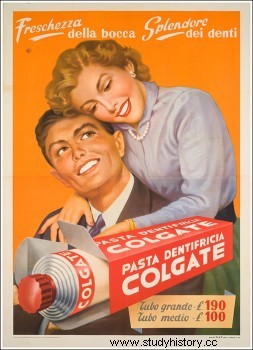
Old advertisement for Colgate toothpaste
As far as toothpaste and toothbrush , as we understand them, are a modern invention, since the dawn of time man has been forced, also for health reasons, to take care of their oral hygiene.
Obviously, he made do with what was available.
Even primitive men they "brushed their teeth".
The prehistoric "toothpaste" was sand, whose natural abrasion abilities were exploited, while the "toothbrush" was the finger, with which the sand was rubbed on the teeth.
It seems that the first to use something more advanced for oral hygiene were the highly evolved Egyptians.
They used a preparation based on salt, pepper, mint leaves and iris, a mixture both cleansing and refreshing.
The ancient Romans they used bicarbonate and urine for a long time (https://www.pilloledistoria.it/1936/storia-antica/ligiene-orale-nellantica-roma-si-lavavano-i-denti-i-romani) before the doctor Scribonio Largo , who lived in the 1st century AD, made the first "toothpaste".
It was a amalgam of vinegar, salt, honey and ... glass splinters, even too abrasive and cleaning.
The ancestors of our toothbrush, for centuries were charcoals and chalks .
During the '800 a compound based on salt, calcium, coal and ... brick dust spread in England , to which in 1824, for the first time, the dentist Peabody added a detergent.
Mid-century Mr. John Harris added gypsum to the aforementioned compound: modern toothpaste was born.
In 1873 it began to be produced and sold on a large scale in large jars, then in bulk.
Later came the more practical folding tubes, initially in metal, then in plastic. .
